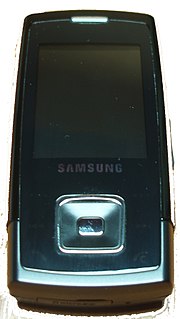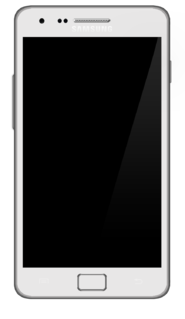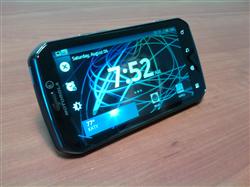The Samsung Wave III, more commonly designated as the Samsung S8600 Wave 3, [1] was released in October 2011 as the successor to the Wave 2 line-up (the S5250, S5330, and S7230). It was a mid-range phone, and sold for €150 ($205). [2] [3]
The Samsung Wave III, more commonly designated as the Samsung S8600 Wave 3, [1] was released in October 2011 as the successor to the Wave 2 line-up (the S5250, S5330, and S7230). It was a mid-range phone, and sold for €150 ($205). [2] [3]
The dimensions of the phone are 125.9x64.2x9.9 mm (4.96x2.53x0.39 in). It comes in a single finish: black. The screen of the phone is protected by Corning Gorilla Glass. [2] The back components of the phone are accessible by sliding an airbrushed aluminum shell upwards. The battery is removable, and removing the battery allows access to the mini-SIM and microSD ports. The camera, LED flash, and loudspeaker are all at the top of the phone on the back. Returning to the front of the phone, there is a single menu button, which is flanked by two capacitive call "buttons" which are activated by touch rather than physical actuation. The volume rocker is on the left side of the phone, and the lock button is on the right side. The two key differences between this model and the previous Wave 2 phones is the switch from physical call buttons to capacitive ones, and the removal of the dedicated camera button on the right side. [1]
The phone display is a Super AMOLED which measures 4 inches along the diagonal, it can display 16M colors. [4] It has a resolution of 480x800, and an area of 45.5 cm^2 (~233 ppi). The phone improves on the last generations' screen-to-body ratio with its own screen-to-body ratio of ~56.3%. The phone screen is protected by Corning Gorilla Glass. Software-wise, touch interaction happens via the TouchWiz UI, and the phone has handwriting recognition. [2]
The phone is powered by a single-core Scorpion processor Qualcomm S2 MSM8255T [5] running at 1.4 GHz. [2] It has 512MB of RAM [6] and an initial storage capacity of 4GB, [2] which is upgradable with an extra 32 GB with the microSD port. [4]
The phone has a 5MP camera with LED flash and autofocus which shoots photos at a resolution of 2560x1920. [7] It can shoot video at 720p @ 30fps. [2] There is a 0.3MP front camera for video calls and selfies at 480p resolution. [6] Photos can be edited via the photo editor.
The phone has a 1500 mAh rechargeable lithium-ion battery. Charging occurs via the microUSB port at the bottom of the phone. On stand-by the phone lasts for 535h on a 2G connection and 517h on a 3G connection. Talk time was 14h 15 minutes on a 2G network and 8h 40 minutes on a 3G network. [2]
The phone can connect to both 2G (GSM 850/900/1800/1900 MHz) and 3G(UMTS 900/2100 MHz). The phone can tap into GPRS, EDGE, UMTS, HSDPA, and HSUPA networks. [7] The phone can also tap into WiFi networks with a WiFi 4 chip, and connect to Bluetooth enabled devices with a Bluetooth 3.0 chip. Users can navigate with A-GPS and Samsung Mobile Navigator. Users can connect the device to a computer via the microUSB port. The phone has a built-in stereo FM radio. [2]
The phone comes pre-packaged with bada OS 2.0, [2] but would not continue to receive updates since bada would be discontinued less than a year after the phones' launch. [8]
The O2 Xda brand was a range of Windows Mobile PDA phones, marketed by O2, developed by O2 Asia and manufactured by multiple OEMs (mainly HTC, Quanta and Arima). The first model was released in June 2002. The last models came to market in 2008. The "X" represents convergence of voice and information/data within one product; the "DA" stands for "Digital Assistant", as in PDA. The name of XDA Developers is derived from it.

The Samsung E900, introduced in 2006, is a high-end mobile phone and is derived from Samsung's D500-D600-D800 series of slide phones. It is of a slide-up design and has touch-sensitive keys, similar to the LG Chocolate (KG800). It was one of the most popular phones at the time but was discontinued late 2007 when buyers then turned their attention to the Samsung D900i, followed by the Samsung U600, which was the slimmest phone by Samsung with a thickness of 1.09 cm (0.43 in) until the E840 was released.

The SGH-F700, marketed as the Ultra Smart F700, is a mobile phone manufactured by Samsung. Using Vodafone as its network provider, the phone was first introduced at the 3GSM World Congress that was held in February 2007. Sales to the European market started November 2007.

The Samsung Omnia II GT-I8000(H/L/U) is a multimedia smartphone announced at Samsung Mobile Unpacked on June 15, 2009. Earlier Omnia II releases run Windows Mobile 6.1, however they are upgradable to version 6.5 Professional. There is also an unofficial and experimental Android version available. Verizon is the official US carrier for this phone and released it in December 2009.

The Samsung Wave is a smartphone developed and produced by Samsung Electronics. It is the first smartphone to run the Bada operating system developed by Samsung Electronics, which was commercially released on May 24, 2010. The Wave is a touchscreen phone powered by Samsung's "Hummingbird" CPU (S5PC110), which includes 1 GHz ARM Cortex-A8 CPU and a built-in PowerVR SGX 540 graphics engine. It also has a "Super AMOLED" screen and 720p high-definition video capture capabilities. Due to shortage of Super AMOLED screens, Samsung released a successor to the device called Wave II and ceased production of the original S8500 model.

The Samsung Wave II S8530 is the Successor of Samsung Wave S8500 smartphone running the bada 1.2 operating system designed by Samsung, which was commercially released on October, 2010. The Wave is a slim touchscreen phone powered by Samsung's "Hummingbird" CPU (S5PC110), which includes 1 GHz ARM Cortex-8 CPU and a powerful built-in PowerVR SGX 540 graphics engine, "Super LCD" screen and 720p high-definition video capture capabilities. Shortage of Super AMOLED screens was one of the primary reasons for the release of this model.

The Samsung Galaxy S II is a touchscreen-enabled, slate-format Android smartphone designed, developed, and marketed by Samsung Electronics, as the second smartphone of the Samsung Galaxy S series. It has additional software features, expanded hardware, and a redesigned physique compared to its predecessor, the Samsung Galaxy S. The S II was launched with Android 2.3 "Gingerbread", with updates to Android 4.1.2 "Jelly Bean".
The Samsung Wave S575 which is the successor of Samsung Wave 525 is the smartphone running the new bada 1.1 Operating system designed by Samsung. Wave 575 was officially released by Samsung on 8 October 2010. The Wave has a slim multi-touch enabled display with 3G Internet connectivity available which is not available in its predecessor.

The Motorola Photon 4G was a high end Android-based mobile smartphone that was distributed exclusively by Sprint. A very similar model was available as the Motorola Electrify from U.S. Cellular.

The Samsung Galaxy Note series was a series of high-end Android phablets and smartphone developed and marketed by Samsung Electronics. The line is primarily oriented towards pen computing; all Galaxy Note models ship with a stylus pen and incorporate a pressure-sensitive Wacom digitizer. All Galaxy Note models also include software features that are oriented towards the stylus and the devices' large screens, such as note-taking, digital scrapbooking apps, tooltips, and split-screen multitasking. The line serves as Samsung's flagship smartphone model, positioned above the Samsung Galaxy S series.
The Samsung Wave 525, also known as the Samsung S5250 or the Samsung Wave 2, is a smartphone which was released alongside the Samsung S8530 in October 2010 as an entry level alternative. The phone was launched with a price tag of $170 (€120).
The Samsung Wave 533, was launched on October 26, 2010 alongside the Samsung Wave 525. Both hardware and software-wise, the S5330 and Samsung Wave 525 are identical except for the inclusion of a pop-out keyboard on the Samsung Wave 533. The phone initially launched with a price of €150 ($210).
The Samsung Wave 723, or Samsung S7230, was released in October, 2010, alongside the Samsung Wave 525 and Samsung Wave 533. It was marketed as a mid-range phone, and cost around €130 ($170).

The Samsung Wave Y, also known as the Samsung S5380 was announced in August 2011 and released later that year in November. It was marketed as a budget alternative to Samsung's higher-end Samsung Wave III. The phone initially sold for €90 (~$120).

The Samsung Galaxy S21 is a series of Android-based smartphones designed, developed, marketed, and manufactured by Samsung Electronics as part of its Galaxy S series. They collectively serve as the successor to the Galaxy S20 series.
The Samsung Wave III S8600 is a smartphone running the Bada 2.0 operating system designed by Samsung, which was commercially released on August, 2011. The Wave is a slim touchscreen phone powered by "Scorpion" CPU, which includes 1.4 GHz ARM Cortex-8 CPU and a powerful graphics engine, "Super LCD" screen and 720p high-definition video capture capabilities. Shortage of Super AMOLED screens was one of the primary reasons for the release of this model.
The Samsung Galaxy F62 is a mid-range Android smartphone manufactured by Samsung Electronics as a part of its Galaxy F series. It is the second phone to be released in the series. It has a 7000 mAh battery, a quad camera setup with a 64 MP main camera, as well as a 12 MP ultrawide camera, a 5 MP macro camera and a 5 MP depth sensor, a 6.7 in (17 cm) Super AMOLED Plus display and Exynos 9825 SoC previously used in Samsung Galaxy Note 10 and Note 10+ flagship smartphones.
Samsung Galaxy A02s is an Android smartphone designed and manufactured by Samsung Electronics as a part of its Galaxy A series. It was announced on 24 November 2020 alongside the Samsung Galaxy A12. Its notable features include an 6.5 inch HD+ PLS TFT display, Qualcomm Snapdragon 450 SoC, a triple rear camera setup and a 5000 mAh battery with 15W fast charging support including a Facial recognition biometric.
The Samsung Galaxy A22 5G is a mid-range Android-based smartphone developed and manufactured by Samsung Electronics as a part of its Galaxy A series. The phone was first released on 24 June 2021. The phone comes with a triple rear camera setup and a 90 Hz display.
Samsung Galaxy F52 5G is a mid-range Android smartphone manufactured by Samsung Electronics. It is the first 5G-capable device in the Galaxy F series. It was announced in May 2021 in China and is the first phone in the Galaxy F series to be available in China.